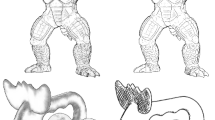Abstract
Renderings of 3D scenes can feature lines drawn automatically along sharp edges between colored areas on object textures, in order to imitate certain styles of hand-drawn line art. However, such “inter-color lines” have been studied very little. Two algorithms for rendering these lines were compared in this study—a faster one utilizing precomputed lines “baked” into the textures and a more complex one that dynamically generates the lines in image space on each frame—for the purpose of determining which of the two better imitated traditional, hand-drawn art styles and which was more visually appealing. In this study, test subjects compared results of the two algorithms side by side, both passively and interactively from a moving camera, and they noted the visual differences to reach final judgments as to which better adhered to artistic conventions and which was more appealing. Statistical analysis of the sample proportions that preferred each algorithm did not show that any significant difference existed between the two algorithms in terms of either of the above metrics. Thus the algorithm using precomputed lines appears to be more recommendable overall, as it is known to be computationally faster, whereas the dynamic algorithm was not shown to be preferred by viewers in terms of conventionality or aesthetics.










Similar content being viewed by others
References
Cardona, L., & Saito, S. (2014). Gaussian curvature based localized stylization method for view-dependent lines extracted from 3D models. In Transactions on computational science XXIII (Vol. 8490, pp. 40–57). Berlin: Springer.
Cole, F., Golovinskiy, A., Limpaecher, A., Barros, H. S., Finkelstein, A., Funkhouser, T., et al. (2012). Where do people draw lines? Communications of the ACM, 55(1), 107–115.
Cole, F., Sanik, K., DeCarlo, D., Finkelstein, A., Funkhouser, T., Rusinkiewicz, S., et al. (2009). How well do line drawings depict shape? In ACM SIGGRAPH 2009 papers (pp 28:1–28:9). New York: ACM.
Constable, M. (2011). Artist-led suggestions towards an approach in content aware 3D non-photorealistic rendering. In Computer vision—ACCV 2010 workshops (Vol. 6469, pp. 142–151).
Dolnicar, S., Grün, B., & Leisch, F. (2011). Quick, simple and reliable: Forced binary survey questions. International Journal of Market Research, 53(2), 231.
Duke, D., Barnard, P., Halper, N., & Mellin, M. (2003). Rendering and affect. Computer Graphics Forum, 22(3), 359–368.
Feldman, U. (1993). Quantifying the dimensions of color experience. Thesis, Massachusetts Institute of Technology.
Gooch, B., Sloan, P. P. J., Gooch, A., Shirley, P., & Riesenfeld, R. (1999). Interactive technical illustration. In Proceedings of the 1999 symposium on interactive 3D graphics (pp. 31–38). New York: ACM.
Goodwin, T., Vollick, I., & Hertzmann, A. (2007). Isophote distance: A shading approach to artistic stroke thickness. In Proceedings of the 5th international symposium on non-photorealistic animation and rendering (pp. 53–62). New York: ACM.
Hajagos, B., Szécsi, L., & Csébfalvi, B. (2012). Fast silhouette and crease edge synthesis with geometry shaders. In Proceedings of the 28th spring conference on computer graphics (pp. 71–76). New York: ACM.
Magdics, M., Sauvaget, C., García, R. J., & Sbert, M. (2013). Post-processing NPR effects for video games. In Proceedings of the 12th ACM SIGGRAPH international conference on virtual-reality continuum and its applications in industry (pp. 147–156). New York.
Masuch, M., Schlechtweg, S., Schönwälder, B., & Magdeburg, D. (1997). daLi!—Drawing animated lines! In O. Deussen & P. Lorenz (Eds.), Proceedings of simulation and animation (pp. 87–96).
Matsuo, T., Mikami, K., Watanabe, T., & Kondo, K. (2011). Shape oriented line drawing in real-time 3DCG. In SIGGRAPH Asia 2011 posters, SA ’11 (pp. 45:1–45:1). New York: ACM.
Mitchell, J. L., Brennan, C., & Card, D. (2002). Real-time image-space outlining for non-photorealistic rendering. In ACM SIGGRAPH conference abstracts and applications (pp. 239–239). New York: ACM.
Mokrzycki, W. S., & Tatol, M. (2011). Color difference Delta E—A survey. Machine Graphics and Vision, 20(4), 383–411.
Nienhaus, M., & Döllner, J. (2004). Sketchy drawings. In Proceedings of the 3rd international conference on computer graphics, virtual reality, visualisation and interaction in Africa, AFRIGRAPH ’04 (pp. 73–81). New York: ACM.
Ohtake, Y., Belyaev, A., & Seidel, H. P. (2004). Ridge-valley lines on meshes via implicit surface fitting. In ACM SIGGRAPH 2004 papers, SIGGRAPH ’04 (pp. 609–612). New York: ACM.
Perrot, M., Habrard, A., Muselet, D., & Sebban, M. (2014). Modeling perceptual color differences by local metric learning. In European conference on computer vision (pp. 96–111). Berlin:Springer.
Rossi, P. H., Wright, J. D., & Anderson, A. B. (2013). Handbook of survey research. London: Academic Press.
Saito, T., & Takahashi, T. (1990). Comprehensible rendering of 3-D shapes. In Proceedings of the 17th annual conference on computer graphics and interactive techniques (pp. 197–206). New York: ACM.
Sanocki, T., Bowyer, K. W., Heath, M. D., & Sarkar, S. (1998). Are edges sufficient for object recognition? Journal of Experimental Psychology: Human Perception and Performance, 24(1), 340–349.
Son, M., Kang, H., Lee, S., & Lee, S. (2007). Abstract line drawings from 2D images. In 15th Pacific conference on computer graphics and applications (pp. 333–342).
Wang, A.-Y., Tang, M., & Dong, J. X. (2004). A survey of silhouette detection techniques for non-photorealistic rendering. In Proceedings of the third international conference on image and graphics (ICIG’04) (pp. 434–437). IEEE.
Wang, S., Ma, Z., Liu, X., Chen, Y., & Wu, E. (2012). Coherence-enhancing line drawing for color images. Science China Information Sciences, 56(11), 1–11.
Author information
Authors and Affiliations
Corresponding author
About this article
Cite this article
Herring, D.G., McGraw, T. Inter-color NPR Lines: A Comparison of Rendering Techniques. Comput Game J 5, 39–53 (2016). https://doi.org/10.1007/s40869-016-0022-3
Received:
Accepted:
Published:
Issue Date:
DOI: https://doi.org/10.1007/s40869-016-0022-3




